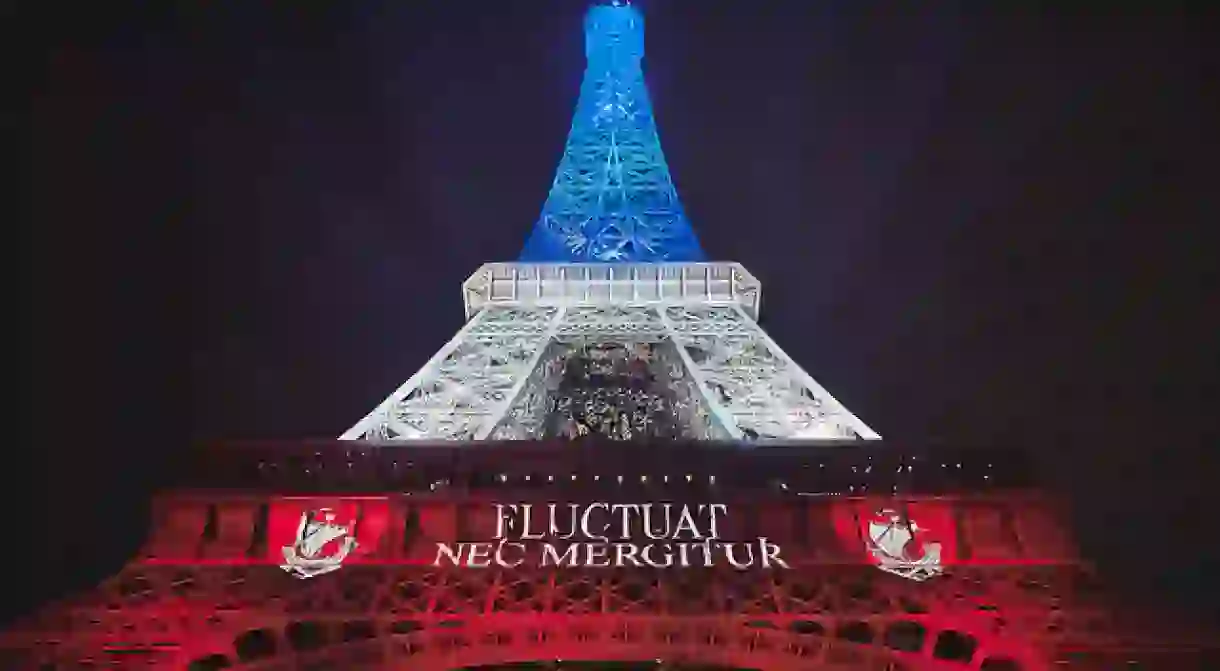Fluctuat Nec Mergitur: Paris' Resilient Motto

Paris’ Latin motto, Fluctuat nec mergitur, has a history nearly as old as the city itself. Seen on the walls of official city buildings and metro stations, the meaning of the phrase was not widely understood until the terrorist attacks of late 2015 saw a resurgence in the use of the phrase, as Parisians began using it in messages of defiance for their attackers.

Every city needs a slogan. For Paris, with its ancient Roman history, the motto is the Latin Fluctuat nec mergitur, meaning ‘Tossed but not sunk,’ or ‘Beaten by the waves, but does not founder.’ Originally used by the Seine boatman’s corporation (les ‘Marchands de l’eau’), this phrase may have been around since before the year 310. The motto is most commonly found on Paris’ coat of arms, accompanied by a motif of a ship bouncing on a stormy sea.
This motif has been unchanged since 1358. It was the symbol of the aforementioned boatman’s corporation, which served as the most important unified body in Paris before it was even a city. This brotherhood of boatmen formed back when Paris was merely a tribe (called the Parisii), who lived on the Île de la Cité, where Notre Dame is now. This tribe relied on the waterways, and thus the boatman’s corporation was of particular consequence.

According to the Mairie of the 1st Arrondissement (the Town Hall), the phrase reflects the incredible history of flooding on the river Seine. Sizable floods have been recorded as far back as 358/359 (by Julius Caesar, no less), and major floods also occurred in the years 582 and 1658. The most significant recent flood (of which we have photos) was in 1910, when the Seine was rendered utterly impassible:

In 1853, Baron Haussmann, the Prefect of the Seine, oversaw a grand renovation of the city of Paris. As part of the project, he adopted Fluctuat nec mergitur as the motto of Paris by official decree.

Today, the coat of arms (along with the motto) can be seen all over Paris. It adorns public buildings, metros, and street signs, likely in places you visit all the time. You’ve probably never noticed it.

Curiously, the phrase has also become a part of the French vernacular, thanks to a novelty song from the 1960s. Georges Brassens’ ‘Les Copains d’abord’ was written in 1964 for the film Les Copains and contains the line ‘Ses fluctuat nec mergitur; C’était pas d’la littérature’:
A very helpful English translation (with notes) is available here, for those that are interested. The song is very popular in France, and many French people have long known the phrase Fluctuat nec mergitur without even recognizing it as the motto of Paris. That may have changed in late 2015.

Following the terrorist attacks of November 13, 2015, the motto began appearing on walls around Paris. In huge block letters, ‘Fluctuat Nec Mergitur’ appeared in graffiti form in Place de la République, and along the Canal St Martin. The scale of the pieces sent a clear message of defiance and solidarity, with Le Monde calling the motto the ‘slogan of resistance‘.
Parisians also took to social media to show their solidarity. This Instagram post by designer Joann Sfar loosely translates to ‘this says ‘screw you’ to death,’ – although in less diplomatic terms:

In the ultimate show of solidarity, the words and motif were superimposed over the French flag (Le Tricolore), and projected on the Eiffel Tower, in the days following the November 13 attacks:

This combination of the two most potent symbols of French nationhood (the flag and the tower) with the city’s own symbol of ‘Paris-ness,’ was shown on televisions and social media all over the world. The phrase has come to realize a new meaning for those Parisians who defy their attackers: while the ship is now merely a metaphor, the spirits of the people in Paris will never founder.













